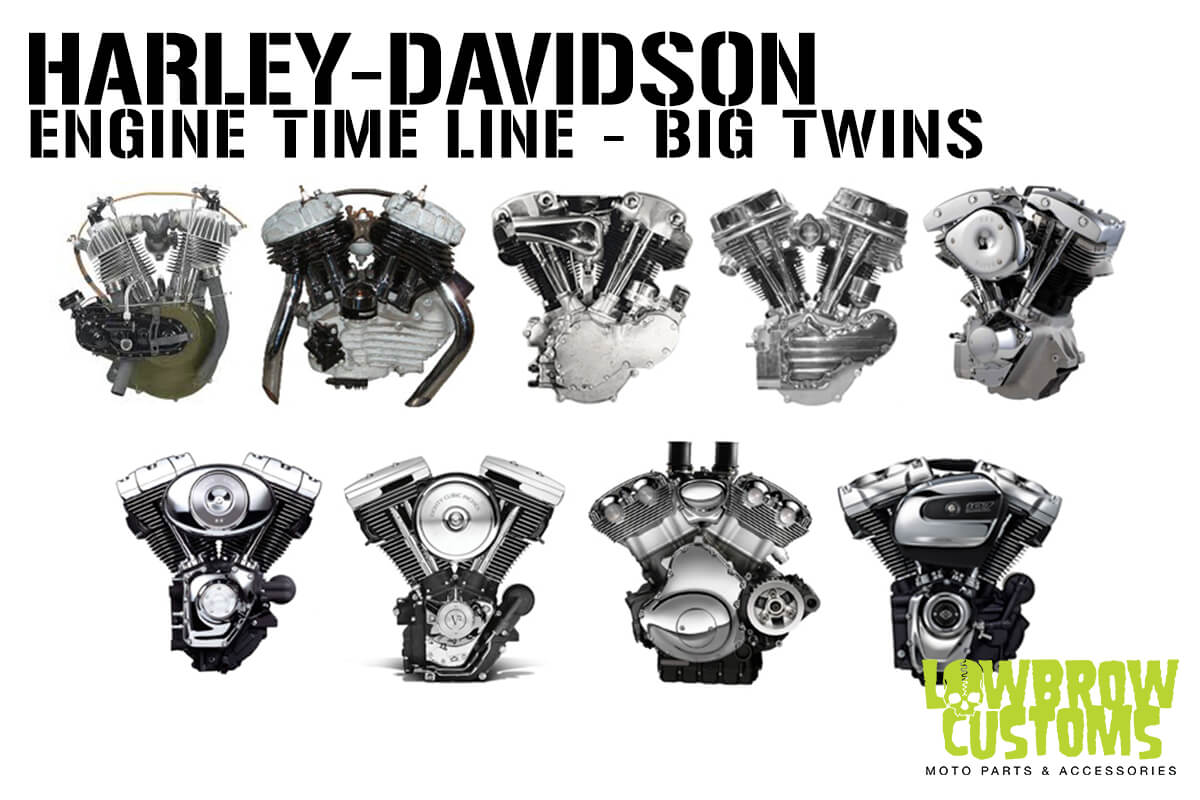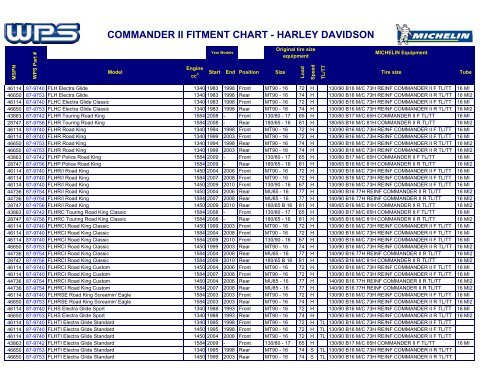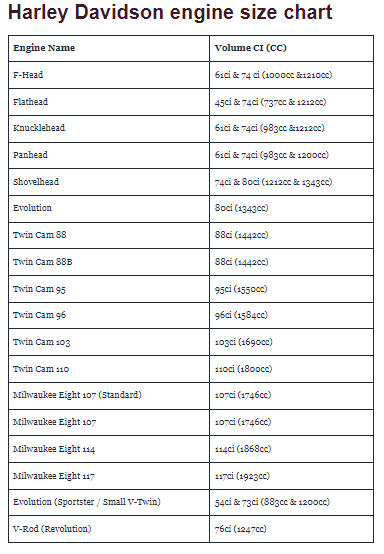Harley Davidson engine sizes range from 500cc to 1923cc. Popular models feature engines like the Milwaukee-Eight and Evolution.
Harley Davidson motorcycles are iconic for their powerful and diverse engines. The brand offers a range of engine sizes to suit different riding styles and preferences. From the nimble 500cc engines for beginners to the robust 1923cc engines for seasoned riders, there’s a Harley Davidson for everyone.
Whether you’re cruising on a Sportster or touring on a Road Glide, understanding the engine size helps in making an informed choice. This guide provides a quick overview of the engine sizes available, helping enthusiasts and potential buyers better navigate their options.
The Legacy Of Harley Davidson Engines
The legacy of Harley Davidson engines is rich and storied. These engines have powered iconic motorcycles for decades. They symbolize freedom, power, and American engineering. Each engine model tells a unique story, contributing to Harley Davidson’s legendary status.
Evolution Through The Decades
Harley Davidson engines have evolved remarkably over the years. Here’s a look at their evolution:
| Decade | Engine Model | Key Features |
|---|---|---|
| 1900s | F-Head | First V-twin engine, 45-degree angle |
| 1930s | Knucklehead | Overhead valve design |
| 1940s | Panhead | Aluminum heads, hydraulic lifters |
| 1960s | Shovelhead | Improved performance, more power |
| 1980s | Evolution | Better reliability, air-cooled |
| 1990s | Twin Cam | Increased displacement, dual cams |
| 2010s | Milwaukee-Eight | Eight valves, cooler running |
Iconic Engine Models
Several Harley Davidson engines stand out in history. These engines are iconic and beloved by riders:
- Knucklehead: Known for its unique look and overhead valves.
- Panhead: Famous for its aluminum heads and hydraulic lifters.
- Shovelhead: Recognized for its improved performance and power.
- Evolution: Celebrated for its reliability and air-cooled design.
- Twin Cam: Noted for its increased displacement and dual cams.
- Milwaukee-Eight: Revered for its eight valves and cooler running.
Each engine model contributes to Harley Davidson’s enduring legacy. They are a testament to innovation and craftsmanship. Riding a Harley with any of these engines is a unique experience.

Credit: www.lowbrowcustoms.com
Decoding The Engine Size Chart
Understanding the Harley Davidson engine size chart can be tricky. This guide will help you decode the chart. It will make it easier to understand engine displacement and metrics.
Understanding Engine Displacement
Engine displacement is the total volume of all the cylinders in an engine. It is measured in cubic inches (ci) or cubic centimeters (cc). A larger displacement usually means more power and torque. Harley Davidson offers various engine sizes to suit different riding styles.
- Street Models: 500cc to 750cc
- Sportster Models: 883cc to 1200cc
- Softail Models: 107ci to 114ci
- Touring Models: 107ci to 117ci
Metrics And Measurements
Understanding the metrics is crucial for choosing the right Harley. Engine size impacts performance, fuel efficiency, and comfort. Here is a table to help you understand the measurements:
| Model | Engine Size (cc) | Engine Size (ci) |
|---|---|---|
| Street 500 | 494cc | 30ci |
| Iron 883 | 883cc | 54ci |
| Fat Boy 114 | 1868cc | 114ci |
| Road Glide Special | 1923cc | 117ci |
Remember, engine size is just one factor. Your riding style and needs are also important. Use this chart to make an informed choice. Happy riding!
Comparing Engine Sizes
Harley Davidson offers bikes with different engine sizes. Each engine size has unique features. Let’s compare the small and big engines in terms of performance.
Small Vs. Big Engines
Small engines are easier to handle. They are great for beginners. Big engines offer more power. They are perfect for experienced riders.
| Engine Size | Advantages | Disadvantages |
|---|---|---|
| Small Engines (500cc – 883cc) |
|
|
| Big Engines (1200cc – 1868cc) |
|
|
Performance Implications
A small engine is ideal for city rides. It offers better fuel economy. A big engine excels on highways. It delivers more power and speed.
Small engines have better maneuverability. They are easier to park and control. Big engines provide a thrilling ride. They are perfect for long journeys.
Choosing The Right Engine Size
Choosing the right engine size for your Harley Davidson bike is crucial. It impacts your riding experience, performance, and comfort. Understanding your needs and preferences helps in making an informed decision.
Rider Experience Level
Your experience level plays a significant role in selecting an engine size. Beginners should avoid high-powered engines. Smaller engines, like 883cc, provide better control and ease of handling.
Experienced riders can handle larger engines. For them, engines like 1200cc or 107ci offer more power and thrill. Always match the engine size with your skill level for safety and enjoyment.
Intended Use And Riding Style
Consider how you plan to use your bike. For city rides and short trips, a smaller engine may suffice. These engines are fuel-efficient and easy to maneuver.
For long-distance touring, a bigger engine is preferable. Larger engines, like 114ci, offer more power and comfort for extended rides. Your riding style also matters. Aggressive riders may prefer higher-powered engines.
| Engine Size | Recommended For |
|---|---|
| 883cc | Beginners, City Riding |
| 1200cc | Intermediate Riders, Mixed Use |
| 107ci | Experienced Riders, Long-Distance Touring |
| 114ci | High Performance, Touring |
Choose wisely by considering these factors. Your perfect Harley Davidson experience awaits!
Impact Of Engine Size On Motorcycle Dynamics
The engine size of a Harley Davidson significantly affects motorcycle dynamics. Different engine sizes impact handling, maneuverability, fuel efficiency, and mileage. Understanding these factors helps riders choose the right bike for their needs.
Handling And Maneuverability
Smaller engines generally offer better handling and maneuverability. They are lighter, making them easier to control. Bikes with smaller engines are often preferred for city rides. They allow for quick turns and easy navigation through traffic.
On the other hand, larger engines provide more power but are heavier. This added weight can make the bike less agile. Riders might find it harder to make quick turns. These bikes are better suited for long highway rides where stability is key.
| Engine Size | Handling | Maneuverability |
|---|---|---|
| Small | Excellent | High |
| Medium | Good | Moderate |
| Large | Fair | Low |
Fuel Efficiency And Mileage
Engine size directly impacts fuel efficiency and mileage. Smaller engines typically consume less fuel. They offer better mileage, making them cost-effective for daily rides. Riders often choose smaller engines to save on fuel costs.
Larger engines, while more powerful, consume more fuel. They have lower mileage, which can be a concern for long-distance riders. But the trade-off is greater power and speed, which some riders prefer.
- Small Engine: High fuel efficiency, better mileage.
- Medium Engine: Balanced fuel efficiency and power.
- Large Engine: Lower fuel efficiency, more power.
Choosing the right engine size is crucial for optimizing both handling and fuel economy. Understanding these dynamics helps in making an informed choice.
Customization And Upgrades
Harley Davidson motorcycles are known for their iconic design and powerful engines. Many riders seek to customize and upgrade their bikes. This helps to enhance performance and create a unique riding experience. Understanding the Harley Davidson Engine Size Chart is crucial. It helps you make informed decisions about modifications and upgrades.
Modifying For More Power
Modifying your Harley Davidson engine can significantly boost performance. Riders often aim to increase horsepower and torque. Common modifications include:
- Air Intake Systems – Improves air flow to the engine.
- Exhaust Systems – Enhances exhaust flow and sound.
- Fuel Management Systems – Optimizes fuel delivery.
- Cams and Camshafts – Alters the timing of valve movements.
- Big Bore Kits – Increases engine displacement.
Each modification impacts the engine’s performance differently. Ensure compatibility with your specific engine size before proceeding.
When To Upgrade Your Engine
Upgrading your Harley Davidson engine can be a big decision. Knowing when to upgrade is essential. Consider the following factors:
- Current Performance – Assess your bike’s current power and efficiency.
- Riding Style – Determine if your riding style demands more power.
- Maintenance Costs – Evaluate the costs of maintaining your current engine.
- Longevity – Consider the lifespan of your existing engine.
- Budget – Ensure you have the budget for the upgrade.
Regularly checking the Harley Davidson Engine Size Chart can help you decide. It ensures compatibility and maximizes the benefits of your upgrades.
Maintenance Tips For Optimal Performance
Maintaining your Harley Davidson engine ensures optimal performance. Regular maintenance can extend your engine’s lifespan. Follow these tips for a smoother ride and a longer-lasting engine.
Routine Checks And Balances
Routine checks are vital for your Harley Davidson. Consistently inspect the oil levels. Low oil can harm the engine. Check it every 1,000 miles. Replace the oil filter with each oil change.
Spark plugs are crucial too. Examine them every 5,000 miles. Clean or replace if needed. Look at the air filter. A clean filter improves fuel efficiency. Replace it every 10,000 miles.
Inspect the brake fluid. It should be clear. Replace it every two years. Check the coolant level. Keep it topped up to prevent overheating. Examine the drive belt for wear and tear. Replace it every 20,000 miles.
Longevity Of Different Engine Sizes
Different engine sizes have different lifespans. Smaller engines, like the 883cc, typically last 50,000 miles. With good care, they can last longer.
Mid-sized engines, like the 1200cc, often reach 75,000 miles. Regular maintenance can extend this lifespan.
Large engines, such as the 1800cc, can last up to 100,000 miles. Proper upkeep ensures they reach this milestone.
| Engine Size (cc) | Average Lifespan (miles) |
|---|---|
| 883cc | 50,000 |
| 1200cc | 75,000 |
| 1800cc | 100,000 |
Regular maintenance is key to extending engine life. Follow these tips to keep your Harley Davidson running smoothly.

Credit: www.yumpu.com
Future Trends In Harley Engine Sizes
The world of Harley Davidson is always evolving. Riders are keen on the latest trends in engine sizes. Knowing what the future holds can be exciting. This section explores future trends in Harley engine sizes.
Innovation In Engine Technology
The future of Harley Davidson engines is bright. Innovation in engine technology is at the forefront. Engineers are working on new designs.
These new engines will be more efficient. They aim to offer better performance. Riders can expect engines with higher horsepower. Fuel efficiency is also a key focus.
Harley Davidson is investing in research. They are exploring hybrid and electric engines. These new engines will reduce emissions. They will also offer a smoother ride.
What Riders Can Expect
Riders can expect a lot from future Harley engines. Here are some key points:
- More powerful engines
- Better fuel efficiency
- Lower emissions
- Smoother performance
- Innovative designs
These advancements will enhance the riding experience. Riders will enjoy longer trips without refueling. The bikes will also be more eco-friendly.
Here’s a table summarizing the expected changes:
| Feature | Current | Future |
|---|---|---|
| Horsepower | 100 HP | 120 HP |
| Fuel Efficiency | 40 MPG | 50 MPG |
| Emissions | High | Low |
| Engine Type | Combustion | Hybrid/Electric |
These trends show the future is promising. Harley Davidson is committed to innovation. Riders will benefit from these advancements.

Credit: www.ebay.com
Conclusion
Choosing the right Harley Davidson engine size is crucial. It ensures a perfect balance of power and comfort. Use this chart to make an informed decision. Enjoy your ride with a well-suited engine. Always consider your needs and preferences. Happy riding!

